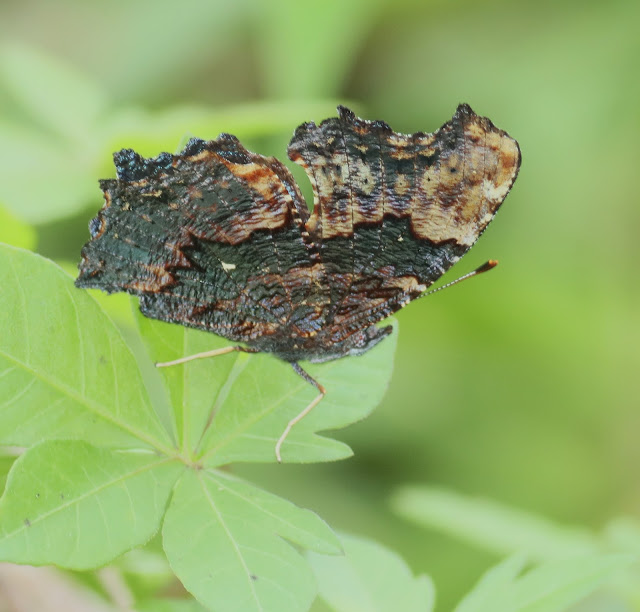The loosen of some restrictions in the movement control order (MCO) recently has provided some leeway to break the routine and to venture out for the first time after 2 months. Weather in the morning is usually bright and sunny while it would rain in the evening. This weather pattern together with fewer humans going out have enticed many butterflies to emerge along the jungle trails.
Here are a few common as well as some uncommon butterflies which you can see in this region:
A) CHOCOLATE ALBATROSS (Appias lyncida)
Initially i thought this butterfly could be a male "Striped Albatross" (Appias libythea) but after further reviewing its photos against other photos in the internet as well as the Singapore's Butterfly Circle's blog, i believe the above butterfly should be a female Chocolate Albatross. Although Chocolate Albatross is common but a female Chocolate Albatross is apparently harder to find than a male Chocolate Albatross.
A male Striped Albatross does have a yellow streak at the base of its underside wings as well as the dark lines liked veins but it does not have the broad dark borders of a female Chocolate Albatross as shown above. This is one of those intriguing thingy about nature's profile.
C. Albatross in flight.
B) ANGLED RED FORESTER (Lethe Chandica)
This is a forest resident
This male has a perfect / undamaged wings.
In Peninsular Malaysia, this butterfly is represented by Ssp L. chandica gopaka.
At a certain angle, its forewing can appear long and high.
It samples minerals from leaves as well.
C) MALAYAN SAILER (Neptis duryodan papaja)
Its underside is much brownish as compared to other sailers.
But when it opens its upper wings, it may looked quite similar as other black-and-white sailers species out there.
This too is a common butterfly of inland forest.
C) CHOCOLATE SAILER (Neptis harita)
Appears like its wearing a blue collar necklace.
Unlike the above Malayan Sailer, the underside of Chocolate Sailer is not brownish.
A frontal view of a Chocolate Sailer
D) PEACOCK PANSY (Junonia almana)
One of the most common and beautiful butterfly which you can find, both along the jungle trails as well as rural areas.
Its under wings however can't really match its upper wings' intense colors.
This Peacock Pansy was seen nectaring on the flowers of a snake weed plant (Stachytarpheta indica), a native plant from South America
D) COURTESAN (Euripus nyctelius)
With a right camera exposure or settings, you should be able to see some bluish hue at the edges of its hindwings. This is a male Courtesan.
You can see a bluish streak on its upper wings here.
Sun bathing while puddling
"V" for victory
A Courtesan in flight
Frontal view of a male Courtesan - looks menacing
E) PLUSH (Sithon nedymond nedymond)
This butterfly is a bit uncommon.
The above butterfly is a female. This butterfly species shows a remarkable distinctive sexual dimorphism whereby the male has brownish bordering with white on its under wings.
A frontal view of a female Plush.
F) COMMON CERULEAN / ROYAL CERULEAN (Jamides caeruleus)
It took me awhile to identify this Blue from the "Rounded Six-line Blue" (Nacaduba berenice) and the "Barred Line Blue" (Prosotas aluta nanda) as well as the "Jewel Four-line Blue" (Nacaduba sanaya elioti). Note: this is one of the most difficult butterfly species to identify (i.e the elpis group).
The semi circular orange band surrounding its main occelli is much broader than the rest of the blues.
According to local butterfly expert (Liew Nyok Lin) the above butterfly is most likely a Jamides alecto ageladas (Metallic Cerulean) showing grey ground color on the undersides with usual white banding. The Singapore's Butterfly Circle group described J. alecto as having a black centred orange-crowned eyespot at the tornal area, with some submarginal orange markings along veins 1b and 4. The white-tipped filamentous tail is at vein 2 of the hindwing. The male of this species has a black diffuse border on the forewing, expanding to about 1mm at the apex and a series of black marginal spots on the hindwing. The female has forewing border extending narrowly along the costa to the base.
Meanwhile here is my layman's conclusion:
i) For
J. caeruleus: the dislocated forewing postdiscal band is at vein
4.
(see photo below)
ii) For
J. alecto ageladas: the forewing postdiscal band is completely dislocated at vein
3.
(based on Singapore Butterfly Circle's description).
(Expert advice: the best indicator for an elpis species is to see its upperwing. Other than that it will be like a guessing game)
G) ANGLED CASTOR (Ariadne ariadne ariadne)
This butterfly was identified from the two white spots at the edge of its forewings. In addition. the Malaysian Ssp of this butterfly has less prominent black wavy lines on its upper wings as shown here.
This heavily battered butterfly is fairly common along the inland forest trail.
H) STRAIGHT LINE MAPWING (Cyrestis nivea)
This mapwing was spotted in a lowland forest in Selangor instead off in some highlands. It was seen puddling or perhaps laying eggs on an abandoned campsite.
I) Corrected to BANDED YEOMAN (Cirrochroa orissa orissa)
J) RUSTIC (Cupha erymanthis)
This butterfly was sunning itself directly in the sun and slightly above eye level. Hence its actual colors were a bit distorted.
K) NARROW-BANDED VELVET BOB (Koruthaialos rubecula)
This aint Bob the Builder but its Bob the Skipper.
L) LESSER DART (Potanthus omaha)
This tiny insect is just 1.2 cm in length.
The above photo could have been more impressive if i had a better camera system.
M) DEMON FLITTER (Oerane microthyrus)
According to Kirton (2014), this skipper is rather scarce.
The above skipper should be a male Demon Flitter due to its overall black and unmarked wings.
N) SPOTTED DEMON (Notocrypta feisthamelii)
Sunbathing after an early morning shower.
REFERENCES:
I) "A Naturalist's Guide to the Butterflies of Peninsular Malaysia, Singapore and Thailand", Laurence G. Kirton, (2014), John Beaufoy Publishing Limited and Forest Research Institute Malaysia (FRIM)


















































.JPG)